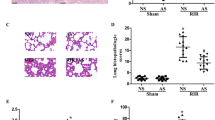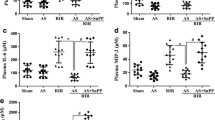Abstract
Introduction
Ischemia and reperfusion injury (IRI) are mainly caused by leukocyte activation, endothelial dysfunction and production of reactive oxygen species. Moreover, IRI can lead to a systemic response affecting distant organs, such as the lungs.
Aim
The objective was to study the pulmonary inflammatory systemic response after renal IRI.
Methods
Male C57Bl/6 mice were subjected to 45 min of bilateral renal ischemia, followed by 4, 6, 12, 24 and 48 h of reperfusion. Blood was collected to measure serum creatinine and cytokine concentrations. Bronchoalveolar lavage fluid (BALF) was collected to determine the number of cells and PGE2 concentration. Expressions of iNOS and COX-2 in lung were determined by Western blot. Gene analyses were quantified by real time PCR.
Results
Serum creatinine increased in the IRI group compared to sham mainly at 24 h after IRI (2.57 ± 0.16 vs. 0.43 ± 0.07, p < 0.01). The total number of cells in BAL fluid was higher in the IRI group in comparison with sham, 12 h (100 × 104 ± 15.63 vs. 18.1×104 ± 10.5, p < 0.05) 24 h (124 × 104 ± 8.94 vs. 23.2×104 ± 3.5, p < 0.05) and 48 h (79 × 104 ± 15.72 vs. 22.2 × 104 ± 4.2, p < 0.05), mainly by mononuclear cells and neutrophils. Pulmonary COX-2 and iNOS were up-regulated in the IRI group. TNF-α, IL-1β, MCP-1, KC and IL-6 mRNA expression were up-regulated in kidney and lungs 24 h after renal IRI. ICAM-1 mRNA was up-regulated in lungs 24 h after renal IRI. Serum TNF-α, IL-1β and MCP-1 and BALF PGE2 concentrations were increased 24 h after renal IRI.
Conclusion
Renal IRI induces an increase of cellular infiltration, up-regulation of COX-2, iNOS and ICAM-1, enhanced chemokine expression and a Th1 cytokine profile in lung demonstrating that the inflammatory response is indeed systemic, possibly leading to an amplification of renal injury.






Similar content being viewed by others
References
Thadhani R, Pascual M, Bonventre JV. Acute renal failure. N Engl J Med. 1996;334:1448.
Bonventre JV, Zuk A. Ischemic acute renal failure: an inflammatory disease? Kidney Int. 2004;66:480.
Friedewald JJ, Rabb H. Inflammatory cells in ischemic acute renal failure. Kidney Int. 2004;66:486.
Thornton MA, Winn R, Alpers CE, Zager RA. An evaluation of the neutrophil as a mediator of in vivo renal ischemic-reperfusion injury. Am J Pathol. 1989;135:509.
Paller MS. Effect of neutrophil depletion on ischemic renal injury in the rat. J Lab Clin Med. 1989;113:379.
Rabb H, Daniels F, O’Donnell M, Haq M, Saba SR, Keane W, Tang WW. Pathophysiological role of T lymphocytes in renal ischemia-reperfusion injury in mice. Am J Physiol Renal Physiol. 2000;279:F525.
Ysebaert DK, De Greef KE, De Beuf A, Van Rompay AR, Vercauteren S, Persy VP, De Broe ME. T cells as mediators in renal ischemia/reperfusion injury. Kidney Int. 2004;66:491.
Yokota N, Burne-Taney M, Racusen L, Rabb H. Contrasting roles for STAT4 and STAT6 signal transduction pathways in murine renal ischemia-reperfusion injury. Am J Physiol Renal Physiol. 2003;285:F319.
Marques VP, Goncalves GM, Feitoza CQ, Cenedeze MA, Fernandes Bertocchi AP, Damiao MJ, Pinheiro HS, Antunes Teixeira VP, dos Reis MA, Pacheco-Silva A, Saraiva Camara NO. Influence of TH1/TH2 switched immune response on renal ischemia-reperfusion injury. Nephron Exp Nephrol. 2006;104:e48.
Daha MR, van Kooten C. Is the proximal tubular cell a proinflammatory cell? Nephrol Dial Transplant. 2000;15(Suppl 6):41.
Kapper S, Beck G, Riedel S, Prem K, Haak M, van der Woude FJ, Yard BA. Modulation of chemokine production and expression of adhesion molecules in renal tubular epithelial and endothelial cells by catecholamines. Transplantation. 2002;74:253.
Safirstein R, Megyesi J, Saggi SJ, Price PM, Poon M, Rollins BJ, Taubman MB. Expression of cytokine-like genes JE and KC is increased during renal ischemia. Am J Physiol. 1991;261:F1095.
Segerer S, Nelson PJ, Schlondorff D. Chemokines, chemokine receptors, and renal disease: from basic science to pathophysiologic and therapeutic studies. J Am Soc Nephrol. 2000;11:152.
Kuzu MA, Koksoy C, Kuzu I, Gurhan I, Ergun H, Demirpence E. Role of integrins and intracellular adhesion molecule-1 in lung injury after intestinal ischemia-reperfusion. Am J Surg. 2002;183:70.
Schmeling DJ, Caty MG, Oldham KT, Guice KS, Hinshaw DB. Evidence for neutrophil-related acute lung injury after intestinal ischemia-reperfusion. Surgery. 1989;106:195.
Foulds S, Mireskandari M, Kalu P, Jackson W, Cheshire NJ, Mansfield AO, Schachter M. Visceral ischemia and neutrophil activation in sepsis and organ dysfunction. J Surg Res. 1998;75:170.
Desai SR. Acute respiratory distress syndrome: imaging of the injured lung. Clin Radiol. 2002;57:8.
Zhou JL, Jin GH, Yi YL, Zhang JL, Huang XL. Role of nitric oxide and peroxynitrite anion in lung injury induced by intestinal ischemia-reperfusion in rats. World J Gastroenterol. 2003;9:1318.
Kelly KJ, Williams W W Jr, Colvin RB, Bonventre JV. Antibody to intercellular adhesion molecule 1 protects the kidney against ischemic injury. Proc Natl Acad Sci USA. 1994;91:812.
Pradelles P, Grassi J, Maclouf J. Enzyme immunoassays of eicosanoids using acetylcholine esterase as label: an alternative to radioimmunoassay. Anal Chem. 1985;57:1170.
Tilney NL, Guttmann RD. Effects of initial ischemia/reperfusion injury on the transplanted kidney. Transplantation. 1997;64:945.
Humes HD. Acute renal failure: prevailing challenges and prospects for the future. Kidney Int Suppl. 1995;50:S26.
Deng J, Hu X, Yuen PS, Star RA. Alpha-melanocyte-stimulating hormone inhibits lung injury after renal ischemia/reperfusion. Am J Respir Crit Care Med. 2004;169:749.
Kelly KJ. Distant effects of experimental renal ischemia/reperfusion injury. J Am Soc Nephrol. 2003;14:1549.
Koksoy C, Kuzu MA, Kuzu I, Ergun H, Gurhan I. Role of tumour necrosis factor in lung injury caused by intestinal ischaemia-reperfusion. Br J Surg. 2001;88:464.
Alves-Filho JC, Freitas A, Souto FO, Spiller F, Paula-Neto H, Silva JS, Gazzinelli RT, Teixeira MM, Ferreira SH, Cunha FQ. Regulation of chemokine receptor by Toll-like receptor 2 is critical to neutrophil migration and resistance to polymicrobial sepsis. Proc Natl Acad Sci USA. 2009;106:4018.
Crofford LJ. COX-1 and COX-2 tissue expression: implications and predictions. J Rheumatol Suppl. 1997;49:15.
Bogdan C. Nitric oxide and the immune response. Nat Immunol. 2001;2:907.
Feitoza CQ, Camara NO, Pinheiro HS, Goncalves GM, Cenedeze MA, Pacheco-Silva A, Santos OF. Cyclooxygenase 1 and/or 2 blockade ameliorates the renal tissue damage triggered by ischemia and reperfusion injury. Int Immunopharmacol. 2005;5:79.
Cavriani G, Oliveira-Filho RM, Trezena AG, da Silva ZL, Domingos HV, de Arruda MJ, Jancar S, Tavares de Lima W. Lung microvascular permeability and neutrophil recruitment are differently regulated by nitric oxide in a rat model of intestinal ischemia-reperfusion. Eur J Pharmacol. 2004;494:241.
Turnage RH, Wright JK, Iglesias J, LaNoue JL, Nguyen H, Kim L, Myers S. Intestinal reperfusion-induced pulmonary edema is related to increased pulmonary inducible nitric oxide synthase activity. Surgery. 1998;124:457.
Turnage RH, Kadesky KM, Bartula L, Myers SI. Intestinal reperfusion up-regulates inducible nitric oxide synthase activity within the lung. Surgery. 1995;118:288.
Matsuyama M, Yoshimura R, Hase T, Kawahito Y, Sano H, Nakatani T. Study of cyclooxygenase-2 in renal ischemia-reperfusion injury. Transplant Proc. 2005;37:370.
Kosaka H, Yoneyama H, Zhang L, Fujii S, Yamamoto A, Igarashi J. Induction of LOX-1 and iNOS expressions by ischemia-reperfusion of rat kidney and the opposing effect of l-arginine. FASEB J. 2003;17:636.
Mehta S. The effects of nitric oxide in acute lung injury. Vascul Pharmacol. 2005;43:390.
Farley KS, Wang LF, Law C, Mehta S. Alveolar macrophage inducible nitric oxide synthase-dependent pulmonary microvascular endothelial cell septic barrier dysfunction. Microvasc Res. 2008;76:208.
Barnes PJ, Chung KF, Page CP. Inflammatory mediators of asthma: an update. Pharmacol Rev. 1998;50:515.
Gauvreau GM, Watson RM, O’Byrne PM. Protective effects of inhaled PGE2 on allergen-induced airway responses and airway inflammation. Am J Respir Crit Care Med. 1999;159:31.
Sestini P, Armetti L, Gambaro G, Pieroni MG, Refini RM, Sala A, Vaghi A, Folco GC, Bianco S, Robuschi M. Inhaled PGE2 prevents aspirin-induced bronchoconstriction and urinary LTE4 excretion in aspirin-sensitive asthma. Am J Respir Crit Care Med. 1996;153:572.
Pavord ID, Ward R, Woltmann G, Wardlaw AJ, Sheller JR, Dworski R. Induced sputum eicosanoid concentrations in asthma. Am J Respir Crit Care Med. 1999;160:1905.
Peacock CD, Misso NL, Watkins DN, Thompson PJ. PGE 2 and dibutyryl cyclic adenosine monophosphate prolong eosinophil survival in vitro. J Allergy Clin Immunol. 1999;104:153.
Profita M, Sala A, Bonanno A, Riccobono L, Siena L, Melis MR, Di Giorgi R, Mirabella F, Gjomarkaj M, Bonsignore G, Vignola AM. Increased prostaglandin E2 concentrations and cyclooxygenase-2 expression in asthmatic subjects with sputum eosinophilia. J Allergy Clin Immunol. 2003;112:709.
Landgraf RG, Nossi DF, Sirois P, Jancar S. Prostaglandins, leukotrienes and PAF selectively modulate lymphocyte subset and eosinophil infiltration into the airways in a murine model of asthma. Prostaglandins Leukot Essent Fatty Acids. 2007;77:163.
Kielar ML, John R, Bennett M, Richardson JA, Shelton JM, Chen L, Jeyarajah DR, Zhou XJ, Zhou H, Chiquett B, Nagami GT, Lu CY. Maladaptive role of IL-6 in ischemic acute renal failure. J Am Soc Nephrol. 2005;16:3315.
Cavriani G, Domingos HV, Soares AL, Trezena AG, Ligeiro-Oliveira AP, Oliveira-Filho RM, Sudo-Hayashi LS, Tavares de Lima W. Lymphatic system as a path underlying the spread of lung and gut injury after intestinal ischemia/reperfusion in rats. Shock. 2005;23:330.
Cavriani G, Domingos HV, Oliveira-Filho RM, Sudo-Hayashi LS, Vargaftig BB, de Lima WT. Lymphatic thoracic duct ligation modulates the serum levels of IL-1beta and IL-10 after intestinal ischemia/reperfusion in rats with the involvement of tumor necrosis factor alpha and nitric oxide. Shock. 2007;27:209.
Acknowledgments
This work was financially supported by Conselho Nacional de Desenvolvimento Científiproco e Tecnológico (CNPq) and FAPESP (06/06236-2, 06/03982-5, 07/07139-3).
Conflict of interest statement
The authors have no conflict of interest.
Author information
Authors and Affiliations
Corresponding author
Additional information
Responsible Editor: M. Katori.
Rights and permissions
About this article
Cite this article
Campanholle, G., Landgraf, R.G., Gonçalves, G.M. et al. Lung inflammation is induced by renal ischemia and reperfusion injury as part of the systemic inflammatory syndrome. Inflamm. Res. 59, 861–869 (2010). https://doi.org/10.1007/s00011-010-0198-0
Received:
Revised:
Accepted:
Published:
Issue Date:
DOI: https://doi.org/10.1007/s00011-010-0198-0




